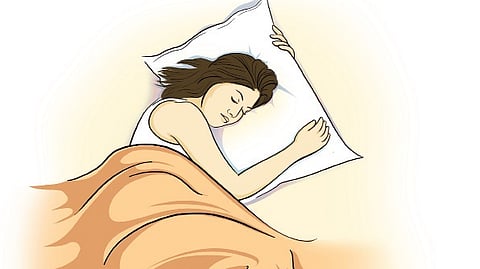

KOCHI: Obstructive Sleep Apnea (OSA) is a sleep-related breathing disorder that involves a decrease or complete halt in airflow despite an ongoing effort to breathe. It occurs when the muscles relax during sleep, causing soft tissue in the back of the throat to collapse and block the upper airway which leads to partial reductions (hypopneas) and complete pauses (apneas) in breathing that last at least 10 seconds during sleep.
This leads to hypoxic awakening of brain causing a brief arousal from sleep that restores normal breathing. This pattern can occur cyclically multiple times in a night, resulting in fragmented quality of sleep and often produces an excessive level of daytime sleepiness. Most people with OSA snore loudly and frequently, with periods of silence when airflow is reduced or blocked then they make choking, snorting or gasping sounds when their airway reopens.
EPIDEMIOLOGY
OSA is the most common sleep-related breathing disorder, which is commonly seen in older males and obese, although it can also affect women and children. Community based epidemiological studies from India have shown that the prevalence of OSA is 2.4 per cent to 5 per cent in males and 1 to 2 per cent in females.
RISK FACTORS
Older age (over 60 years of age)
Male (similar in post-menopausal women)
Genetic factors
Obesity
People with large neck sizes
Endocrine factors: Acromegaly, Hypothyroidism, PCOD, pregnancy and post-menopausal age.
Craniofacial abnormalities: Retro-posed small chin, tonsil or adenoid enlargement, nasal-obstruction, large tongue (Down’s Syndrome) and upper airway tumours.
Smoking
Medical conditions: Hypertension, congestive heart failure, end stage renal disease, stroke, chronic lung disease like asthma, COPD, IPF, Parkinson’s, fibromyalgia, gastroesophageal reflux disease.
CLINICAL PRESENTATION
Excessive daytime sleepiness: Fatigue, poor concentration, decreased cognition, drowsiness while driving due to non-restorative sleep.
Snoring, choking, gasping during sleep
Morning headaches
Sleep disturbance, nocturia, dry mouth, bruxism, nocturnal angina/palpitations.
Consequences of persistent interrupted sleep: Chronic elevation in daytime blood pressure; decreased libido; increased risk of stroke; higher rate of death due to heart disease; impaired glucose tolerance and insulin resistance; impaired concentration; mood changes; increased risk of being involved in a deadly motor vehicle accident; and disturbed sleep of the bed partner.
COMPLICATIONS
Cardiovascular and cerebrovascular (hypertension, coronary artery disease, cardiac arrhythmias, heart failure, and stroke)
Metabolic syndrome and diabetes
Excessive day time sleepiness, resulting in potential motor vehicle crashes (up to three times more common)
Neuropsychiatric (inattention, memory, moodiness and irritability as well as depression, psychosis, and sexual dysfunction)
Pulmonary hypertension or right heart failure
Non-alcoholic fatty liver disease, gout, decreased quality of life
DIAGNOSIS
Polysomnography (sleep study) — Attended in-laboratory polysomnography (PSG) is considered the gold-standard diagnostic test for OSA. Home sleep apnea testing (using portable sleep monitors) is usually preferred in high probability patients.
MANAGEMENT
PAP therapy: All patients diagnosed with OSA should be offered Positive Airway Pressure (PAP) as initial therapy. It is mainstay of therapy for adults with OSA.
CPAP (Continuous PAP): It is the preferred mode. APAP (Automatic PAP) may be similar to CPAP but with slightly lesser evidence.
Oral appliances (mandibular advancement devices, tongue retaining devices): They are an alternative therapeutic strategy in OSA that may be offered to selected patients.
Upper airway surgery: Alternative therapy with insufficient data.
Hypoglossal nerve stimulation: An upcoming method in selected patients only.
(The writer is a consultant pulmonologist, Fortis Hospital, Richmond Road, Bengaluru)